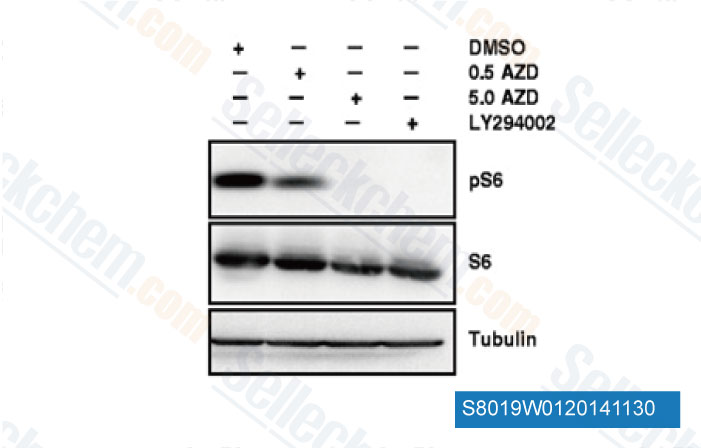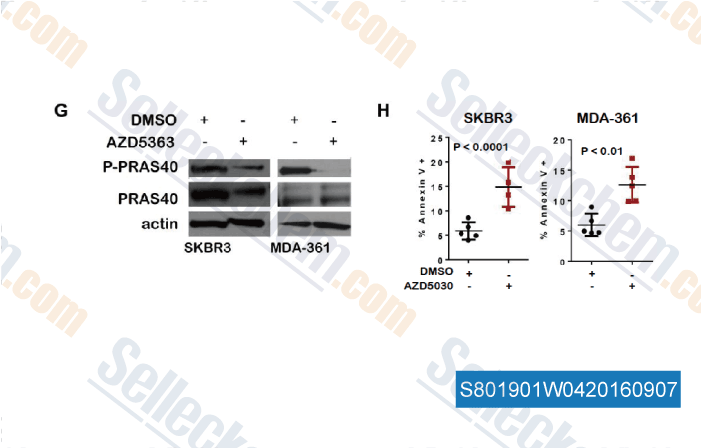|
Toll Free: (877) 796-6397 -- USA and Canada only -- |
Fax: +1-832-582-8590 Orders: +1-832-582-8158 |
Tech Support: +1-832-582-8158 Ext:3 Please provide your Order Number in the email. |
Technical Data
| Formula | C21H25ClN6O2 |
|||
| Molecular Weight | 428.92 | CAS No. | 1143532-39-1 | |
| Solubility (25°C)* | In vitro | DMSO | 88 mg/mL (205.16 mM) | |
| Ethanol | 29 mg/mL (67.61 mM) | |||
| Water | Insoluble | |||
|
* <1 mg/ml means slightly soluble or insoluble. * Please note that Selleck tests the solubility of all compounds in-house, and the actual solubility may differ slightly from published values. This is normal and is due to slight batch-to-batch variations. * Room temperature shipping (Stability testing shows this product can be shipped without any cooling measures.) |
||||
Preparing Stock Solutions
Biological Activity
| Description | Capivasertib (AZD5363) potently inhibits all isoforms of Akt(Akt1/Akt2/Akt3) with IC50 of 3 nM/8 nM/8 nM in cell-free assays, similar to P70S6K/PKA and lower activity towards ROCK1/2. Phase 2. | ||||||||
|---|---|---|---|---|---|---|---|---|---|
| Targets |
|
||||||||
| In vitro | AZD5363 is a potent Akt inhibitor with IC50 of 3 nM, 8 nM and 8 nM for Akt1, Akt2 and Akt3, respectively. [1] AZD5363 inhibits phosphorylation of AKT substrates in cells with a potency of approximately 0.3 to 0.8 μM. AZD5363 inhibits the proliferation of 41 of 182 solid and hematologic tumor cell lines with a potency of < 3 μM. [2] Activating mutations in PIK3CA, loss or inactivation of tumor suppressor PTEN, or HER2 amplification all are significantly predictive of responsiveness to AZD5363. Additionally, correlation is also seen between the RAS mutation status of cell lines and resistance to AZD5363. [1] | ||||||||
| In vivo | Oral dosing of AZD5363 (100, 300 mg/kg) to nude mice causes dose- and time-dependent reduction of PRAS40, GSK3β, and S6 phosphorylation in BT474c xenografts, reversible increases in blood glucose concentrations, and dose-dependent decreases in 2[18F]fluoro-2-deoxy-d-glucose (18F-FDG) uptake in U87-MG xenografts. Chronic oral dosing of AZD5363 (130, 200, and 300 mg/kg) causes dose-dependent growth inhibition of xenografts derived from various tumor types, including HER2+ breast cancer models that are resistant to trastuzumab. AZD5363 also significantly enhances the antitumor activity of docetaxel, lapatinib, and trastuzumab in breast cancer xenografts. [2] | ||||||||
| Features | Moderate preclinical tolerability, and PD characteristics of an AKT inhibitor. Distinct profile from other AKT inhibitors in clinical development. |
Protocol (from reference)
| Kinase Assay:[1] |
|
|---|---|
| Cell Assay: [2] |
|
| Animal Study:[2] |
|
References
|
Customer Product Validation

-
Data from [Data independently produced by Cell Commun Signal, 2014, 12(1), 61]

-
Data from [Data independently produced by PLoS One, 2014, 9(10), e108780]

-
Data from [Data independently produced by , , Clin Cancer Res, 2016, 22(4):1018-27]

-
Data from [Data independently produced by , , Cancer Res, 2016, 76(16):4752-64.]
Selleck's Capivasertib (AZD5363) has been cited by 135 publications
| Dual targeting of the androgen receptor and PI3K/AKT/mTOR pathways in prostate cancer models improves antitumor efficacy and promotes cell apoptosis [ Mol Oncol, 2024, 10.1002/1878-0261.13577] | PubMed: 38225213 |
| Dual Targeting of Apoptotic and Signaling Pathways in T-Lineage Acute Lymphoblastic Leukemia [ Clin Cancer Res, 2023, 29(16):3151-3161] | PubMed: 37363966 |
| Mediation of PKM2-dependent glycolytic and non-glycolytic pathways by ENO2 in head and neck cancer development [ J Exp Clin Cancer Res, 2023, 42(1):1] | PubMed: 36588153 |
| Dual Targeting of Apoptotic and Signaling Pathways in T-Lineage Acute Lymphoblastic Leukemia [ Clin Cancer Res, 2023, 29(16):3151-3161] | PubMed: 37363966 |
| Crosstalk between tumor acidosis, p53 and extracellular matrix regulates pancreatic cancer aggressiveness [ Int J Cancer, 2023, 152(6):1210-1225] | PubMed: 36408933 |
| FAP is critical for ovarian cancer cell survival by sustaining NF-κB activation through recruitment of PRKDC in lipid rafts [ Cancer Gene Ther, 2023, 30(4):608-621] | PubMed: 36494579 |
| Suppression of androgen receptor signaling induces prostate cancer migration via activation of the CCL20-CCR6 axis [ Cancer Sci, 2023, 114(4):1479-1490] | PubMed: 36479732 |
| Suppression of androgen receptor signaling induces prostate cancer migration via activation of the CCL20-CCR6 axis [ Cancer Sci, 2023, 114(4):1479-1490] | PubMed: 36479732 |
| Bcl-xL Is a Key Mediator of Apoptosis Following KRASG12C Inhibition in KRASG12C-mutant Colorectal Cancer [ Mol Cancer Ther, 2023, 22(1):135-149] | PubMed: 36279564 |
| Bcl-xL Is a Key Mediator of Apoptosis Following KRASG12C Inhibition in KRASG12C-mutant Colorectal Cancer. [ Mol Cancer Ther, 2023, (1): 135–149.] | PubMed: None |
RETURN POLICY
Selleck Chemical’s Unconditional Return Policy ensures a smooth online shopping experience for our customers. If you are in any way unsatisfied with your purchase, you may return any item(s) within 7 days of receiving it. In the event of product quality issues, either protocol related or product related problems, you may return any item(s) within 365 days from the original purchase date. Please follow the instructions below when returning products.
SHIPPING AND STORAGE
Selleck products are transported at room temperature. If you receive the product at room temperature, please rest assured, the Selleck Quality Inspection Department has conducted experiments to verify that the normal temperature placement of one month will not affect the biological activity of powder products. After collecting, please store the product according to the requirements described in the datasheet. Most Selleck products are stable under the recommended conditions.
NOT FOR HUMAN, VETERINARY DIAGNOSTIC OR THERAPEUTIC USE.
